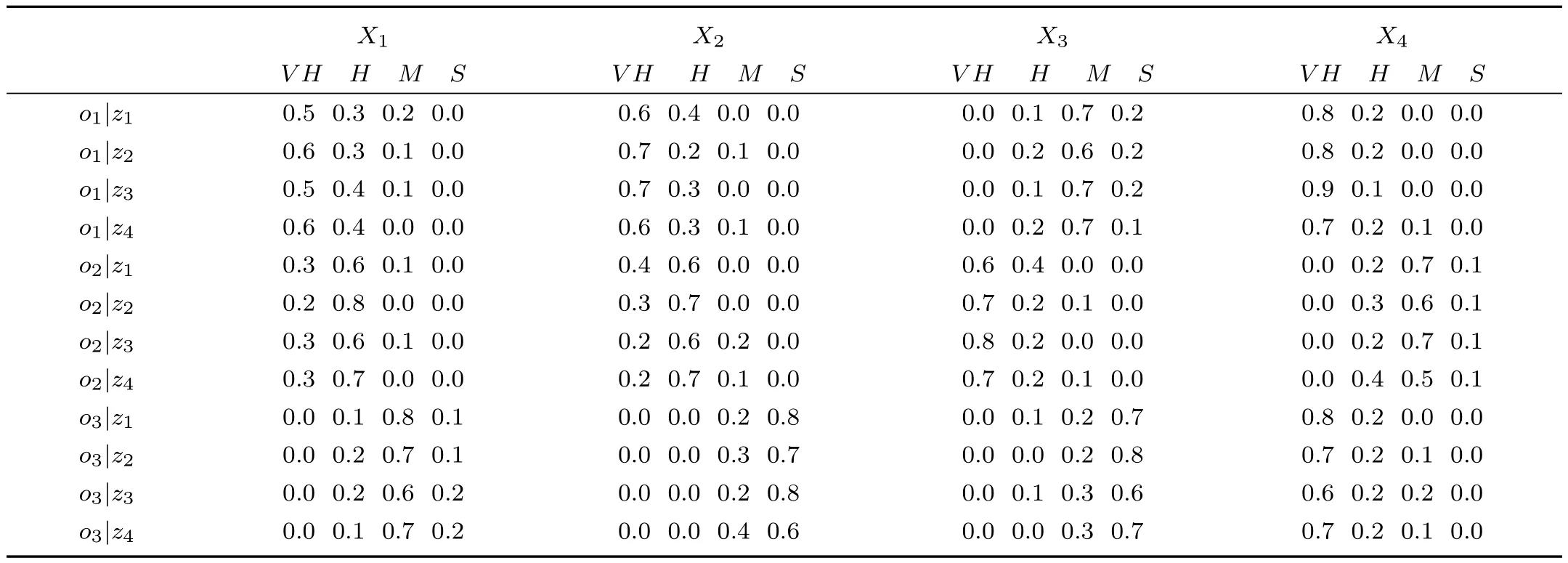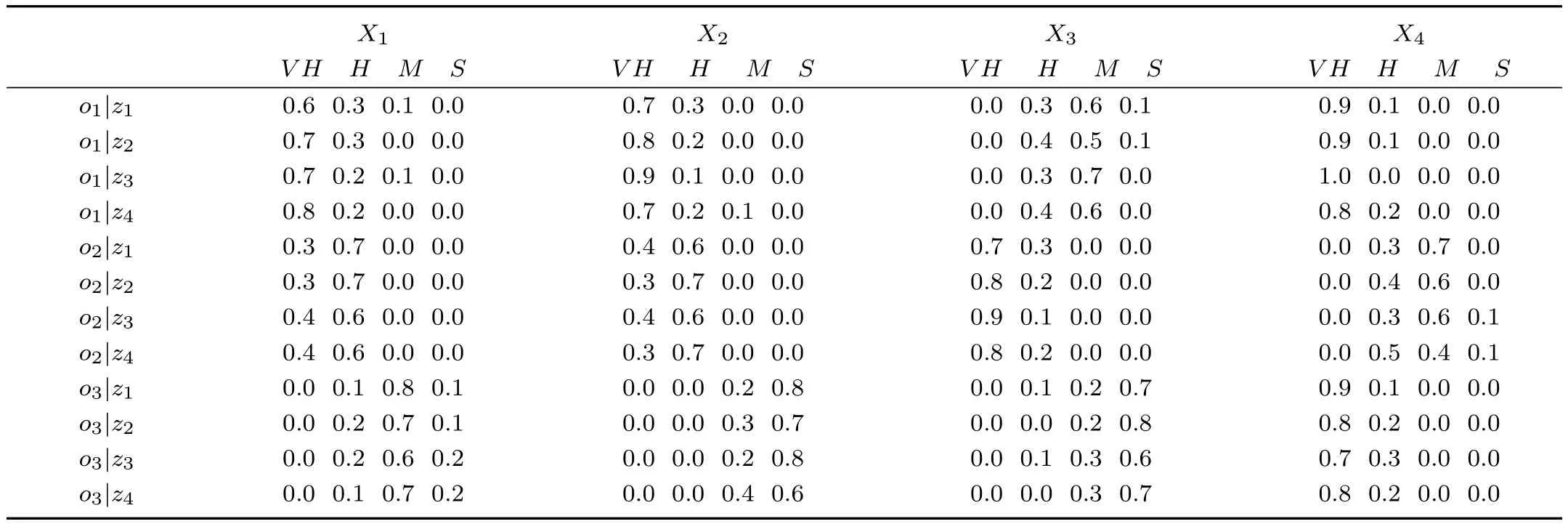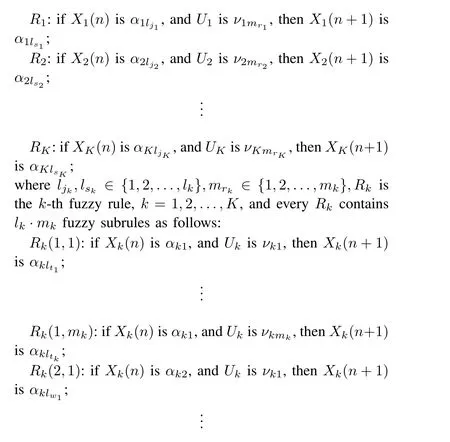Linguistic Dynamic Modeling and Analysis of Psychological Health State Using Interval Type-2 Fuzzy Sets
2015-08-09HongMoJieWangXuanLiandZhanlinWu
Hong Mo,Jie Wang,Xuan Li,and Zhanlin Wu
Linguistic Dynamic Modeling and Analysis of Psychological Health State Using Interval Type-2 Fuzzy Sets
Hong Mo,Jie Wang,Xuan Li,and Zhanlin Wu
—The study of psychological health state is helpful to build appropriate models and take effective intervention strategies,and the results benefit the intervened released from psychological distress within the shortest possible time.In this paper,interval type-2 fuzzy sets and fuzzy comprehension evaluation are applied in the analysis of mental health status and crisis intervention.A closed-loop linguistic dynamic intervention model for psychological health state is built.Linguistic dynamic systems based on interval type-2 fuzzy sets are used to describe and analyze the evolutionary process of psychological health status.
Index Terms—Linguistic dynamic systems(LDS),interval type-2 fuzzy sets,psychological health state.
I.INTRODUCTION
I N modern society,psychological crisis has become a social problem,and the pressure people bear increases unceasingly.The assessment of psychological health state and the crisis intervention have been hot topics for psychological research[1].The achievement related to the research can help to build up reasonable evaluation,and reasonable rule base built by analysis of psychological health status for a large number of individuals can provide guidance for people to take moderate and appropriate psychological intervention,and improve the efficiency of disposing psychological crisis.
In 1964,Caplan provided principles of preventive psychiatry[2],since then the study of psychological health status has been noticed.Till now,many findings of theories and applications for the evaluation of psychological health state and crisis intervention have appeared.Caplan gave the representations for psychological crisis,and presented its source,classification,evolution process and intervention[2-4], and these works lay the foundation for the theory study of psychological crisis intervention.James and Gilliland used three basic modes of crisis intervention to help individual to prevent or alleviate the psychological trauma[5].Roberts took a synthesis ACT crisis intervention mode to deal with sudden crisis and traumatic crisis,and achieved good result to intervene the high risk group of the local events honor 9/11 by the mode[6].In China,Zhang et al.and Chen et al. discussed the intervention for college student’s interpersonal communication[7-8].Zhang et al.studied relative questions of psychological crisis and crisis intervention[9].However, these intervention modes are too many to unify for guiding intervention process,and the empirical research is very little. Thus,it is necessary to build a set of effective mechanism for the evaluation and intervention of psychological health state.
Hong Mo,Jie Wang,and Xuan Li are with the College of Electric and Information Engineering,Changsha University of Science and Technology,Changsha 410114,China(e-mail:mohong198@163.com;wangjiecsust@163.com; lixuan0125@126.com).
Zhanlin Wu is with the College of Electric and Information Engineering, Changsha University of Science and Technology,Changsha 410114,China, and also with Guilin Power Corporation,Guilin 541004,China(e-mail: wuzhanlin98@126.com).
At the same time,the knowledge on evaluation for psychological health state and crisis intervention are mainly perception information.In daily life,the description and analysis of these questions are mainly in natural language,so how to use natural language to deal with the evaluation for psychological health state and crisis intervention is the key to solve the problem.In the meantime,the factors affecting people’s psychological health state include many reasons,and the impacts of every factor maybe not be the same.Then it is necessary for us to analyze the psychological health state and provide crisis intervention from multi-factors and dynamic methods to describe the process objectively.Type-2 fuzzy sets(T2 FSs) can help us solve the problems of language ambiguity and data noise better than the corresponding type-1.As an effective method for the solution to perceptional information,T2 FSs have been used to deal with some practical problems[10-13]. The questions of multi-factors can be managed by the method of fuzzy comprehensive evaluation.The two methods can let us to describe uncertainty of language,but their description and analysis are static.
In linguistic dynamic systems(LDS),computing with words is used to substitute conventional numerical symbolic computation,and the modeling,analysis,evaluation and decisionmaking can be at the level of language[14-17].In the past years,LDS were mainly on 1-D universe.However,there aremany factors to be evaluated,so it is necessary to consider LDS on multi-dimension universe.Wang’s fuzzy comprehension evaluation can help people to provide the assessment results for many factors[18],but it is static.Meanwhile,how to give the evaluation,for different experts,there are different means.It is necessary to use the theories of type-2 fuzzy sets and linguistic dynamic systems to describe and analyze the evolutionary process of the evaluation for psychological health state.
In the paper,interval type-2 fuzzy sets(IT2 FSs),linguistic dynamic systems(LDS)and fuzzy comprehension evaluation are used to build up the models for psychological health state and its intervention,and provide the linguistic dynamic description for the evolutionary of psychological health state. The paper is arranged as follows:Section II is the introduction of terminologies;In Section III,the evaluation of psychological health state is discussed;Section IV presents the linguistic dynamic description of psychological health state;linguistic dynamic modeling of psychological crisis intervention is described in Section V;Section VI provides the conclusion.
II.PRELIMINARY
In 1995,Wang provided the theory of linguistic dynamic systems[19].In LDS,the state equation,output equation and the feedback equation are converted to the corresponding linguistic forms[20-22]:
The state equation of LDS is

The output equation of LDS is

The feedback equation of LDS is

where Z={0,1,...,K},N1,N2,N3,N4are all positive numbers,X(k)∈IN1is the state word of the system, Y(k)∈IN3the output word,V(k)∈IN4the input word, U(k)∈IN2the control word,k the discrete time series,and F,H,R are all fuzzy logic operators defining the system, output and control mapping of LDS,respectively
Let C(2I)is a set of all the nonempty close subsets of I. A T2 FS ω on Ω is defined as[22-23]

where x(or u,z)is the primary(or secondary,third)variable, Lx⊆[0,1]is the primary membership grade,defined by the following multi-value mapping:

i.e.,for every x∈Ω,there is Lx∈C(2I),such that






If Ω and Lxare all discrete,then ω is a discrete T2 FS on Ω,and can be written as



where Lx=[ax,bx].
III.DESCRIPTION AND EVALUATION OF PSYCHOLOGICAL HEALTH STATE ON IT2 FSS
Psychological health state is divided into the following four scenarios:health,sub-health,ill health and disease[23], represented by q3,q2,q1,q0,respectively.The observation and evaluation for the psychological health state and intervention form the close-loop-intervention model of psychological state as Fig.1.

Fig.1.Close-loop-intervention model of psychological state.
The psychological pressure is an inevitable factor of psychological disease[24].So in the paper,the study of psychological health state is converted to the evaluation of psychological pressure and its intervention.At the same time,psychological pressure has many typical characteristics,for example,diversity,time-variance,etc.
Let Ω={o1,o2,...,oN}be the set being observed.For every on(n=1,2,...,N),Pn,Qnare the psychologicalpressure and psychological endurance ofon,respectively and ΔPnis the error betweenPnandQn,i.e.,

There are four IT2 FSs{ω1,ω2,ω3,ω4}={positive high, positive medium,positive small,non-positive}on the universe of ΔPn.
According to the above assumption,the corresponding fuzzy rules are as follows:

whereXis the variable of pressure sources,also the universe of pressure source.By the following four steps,type-2 fuzzy comprehensive evaluation can be used to evaluate the psychological health state of every person.
Step 1.Determination of the factor set
The factor setXcontainsKfactors,written as

whereXk,k=1,2,...,Kis one of the pressure sources,andKis a nature number.
Step 2.Determination of the evaluation set
For every pressure sourceXk,k=1,2,...,K,the assess value is expressed by four basis words{very high,high, medium,small},i.e.,

where{V H,H,M,S}is the abbreviation of{very high, high,medium,small},respectively,and used in the following context.
Step 3.Determination of the weight of every factor
Different element of the factor set may play different pole in the comprehensive evaluation,then the weight vector is represented as


Step 4.Determination of the fuzzy comprehension evaluation matrix
For the pressure sourceX1,...,Xk,...,XKand the corresponding assess basis wordsv1,...,v4,letZ={z1,...,zM}be the set of evaluation experts,and the assessed value byzm,m=1,2,...,Mfor all the observed{o1,o2,...,oN}is in Table I.


Step 5.Comprehension evaluation
Psychological endurance is the regular and overall performance of the personal to the pressure.Let the psychological endurance ofonbeQn,then the error between the evaluation result byzmand the psychological endurance is



Thus,ωi,i=1,...,4 can be represented by a half discrete IT2 FS,and its primary membership grade is defined as follows:


TABLE I EVALUATION BYzmFOR ALL OBJECTIVES
where

Thenωi,i=1,...,4 can be written as

By the above fuzzy rules and the match degree method[22], it is not difficult to obtain its match degree with basis words of every rule,and its psychological state ofon,together with the linguistic dynamic modeling of the psychological health state foron.
Example 1.The psychological state of three employees{o1,o2,o3}is observed by four experts{z1,z2,z3,z4}.The pressure source consists of four factors{X1,X2,X3,X4}and the evaluation of every factor is described by four basis words

and the weight vector is

The evaluation is as Table II,whereN=3,M=K=4.
From the above discussion,the fuzzy comprehension evaluation results are in Table III.
In Table III,when 4n-3≤i≤4n,n=1,2,3,if 1≤j≤4,rijis the membership grade toωjforonevaluated byzi-4(n-1).And the corresponding the primary membership grade are as follows:


Then the corresponding half discrete IT2 FSs can be written as

From the representation,it is not difficult to see that the psychological pressure ofo1is higher thano2ando3,and that ofo3is much less.
IV.LINGUISTIC DYNAMIC DESCRIPTION OF PSYCHOLOGICAL HEALTH STATE
By the above analysis,it is easy to see that for the given datum of some object,type-2 fuzzy sets can be used to describe the states.The work of the description for psychological state is static,but the evolution of psychological healthy state is dynamic,and linguistic dynamic systems can be used to describe the evolution procedure.
Different element of the factor set may play different role in the comprehensive evaluation,and even for the same person, the factor’s weight is different at different time,then Steps 3-5 should be modified as follows:

TABLE II EVALUATION FOR ALL OBJECTIVES

TABLE III COMPREHENSION EVALUATION RESULTS
Step 3∗.Determine the weight of every factor




Step 5∗.Comprehension evaluation



wherei=1,...,4.

ωi(t)can be written as

whent=k T,k=0,1,2,...,then the evaluation resultωi(t) forms linguistic dynamic orbit as follows:

For simplicity,it is written as



From Tables IV and V,by the method of fuzzy comprehension evaluation,the corresponding assessments can be represented as

By the assessment results,it is easy to see that with time changing,the psychology states ofo1,o2become higher and higher,at the same time,that ofo3is much less than before.
Whent=3T,4T,...,by the evaluation process,foro1,o2,o3,the assessment results areωi(3),ωi(4),...,then the linguistic dynamic orbit of psychological pressure foro1,o2,o3is as follows:


TABLE IV EVALUATION FOR ALL OBJECTIVES ATt=T

TABLE V EVALUATION FOR ALL OBJECTIVES ATt=2T
V.LINGUISTIC DYNAMIC MODELING FOR PSYCHOLOGICAL CRISIS INTERVENTION
If the psychological pressure is high or very high,then it is not the expected state,and necessary to be intervened, otherwise it may become worse than before,aso1,o2in Example 2.Psychological intervention is the process to make the psychological health state be converted to the expected target according to the instruction of psychological theory[5,25-26]. The target of all intervention models is to alleviate the symptoms of acute emergencies,restore the initiative,alleviate the psychological trauma and posttraumatic stress disorder. Health mental state can be reached by being provided proper interventions.
In the paper,IT2 FS is used to describe the psychological intervention strategy.If the factor affecting psychological health state is different,intervention measures are also different. Let the set of factors be{X1,X2,...,XK},and for every factorXk,the variable onXkis also represented asXkand the corresponding judgement set is{αk1,...,αklk}.If there aremkkinds of intervention measures{νk1,...,νkmk},then by the expert’s experiment knowledge,the fuzzy rules are represented as follows:


For the k-th factor Xk,if the initial words on Xkis αk(0), there is

i.e.,only fuzzy rule Rkis activated,and



Might as well let

then the corresponding intervention strategy νkmrkis the best one.That is to say,once the intervention target is given,the best intervention strategy can be determines by the fuzzy rules.
VI.CONCLUSION
In the paper,fuzzy comprehension evaluation and interval type-2 fuzzy sets are used to assess the psychological health state,and the corresponding linguistic dynamic modeling is built to analyze the evolution process,and the best intervention strategy is provided when the initial state and intervention target are given.
Big data plays a very important role in modern life.The future work will use big data to provide T2 FSs and linguistic dynamic orbit.
REFERENCES
[1]Morgan O W,Sribanditmongkol P,Perera C,Sulasmi Y,van Alphen D,Sondorp E.Mass fatality management following the South Asian tsunami disaster:case studies in Thailand,Indonesia,and Sri Lanka. PLoS Medicine,2006,3(6):e195
[2]Caplan G.Principles of Preventive Psychiatry.New York:Basic Books, 1964.
[3]Caplan G.The Theory and Practice of Mental Health Consultation.New York:Basic Books,1970.
[4]Caplan G.Support Systems and Community Mental Health:Lectures on Concept Development.New York:Basic Books,1974.
[5]James R K,Gilliland B E.Crisis Intervention Strategies(Fifth edition). CA:Thomson Brooks/Cole,2004.
[6]Roberts A R.Assessment,crisis intervention,and trauma treatment: the integrative ACT intervention model.Brief Treatment and Crisis Intervention,2002,2(1):1-22
[7]Zhang Lan-Jun,Zheng Ya-Rong.Effect of psychological training and exercise on interpersonal sensitivity of college students.Chinese Mental Health Journal,2004,18(5):314-315(in Chinese)
[8]Chen Rong,Qin Zhu,Chu Geng-Wu,Zhao Zong-Yi,Zhang Li,Lei Ling,Xu Xiu-Feng.Expremental research on the training of intercourse to reduce the student psychological reaction to emergency.Health Psychology Journal,2003,11(6):410-413(in Chinese)
[9]Zhang Feng-Hua,Fang Lai-Tan,Gao Peng.Research on mental crisis and mental crisis intervention.World Science Technology Research and Development,2008,30(4):504-508(in Chinese)
[10]Hagras H A.A hierarchical type-2 fuzzy logic control architecture for autonomous mobile robots.IEEE Transactions on Fuzzy Systems,2004, 12(4):524-539
[11]Mendel J M,John R I B.Type-2 fuzzy sets made simple.IEEE Transactions on Fuzzy Systems,2002,10(2):117-127
[12]Ag¨uero J R,Vargas A.Calculating functions of interval type-2 fuzzy numbers for fault current analysis.IEEE Transactions on Fuzzy Systems, 2007,15(1):31-40
[13]Li C D,Yi J Q,Zhang G Q.On the monotonicity of interval type-2 fuzzy logic systems.IEEE Transactions on Fuzzy Systems,2014,22(5): 1197-1212
[14]Li C D,Zhang G Q,Wang H D,Ren W N.Properties and data-driven design of perceptual reasoning method based linguistic dynamic systems. Acta Automatica Sinica,2014,40(10):2221-2232
[15]Wang Fei-Yue.Fundamental issues in research of computing with words and linguistic dynamic systems.Acta Automation Sinica,2005,31(6): 844-852(in Chinese)
[16]Wang F Y.On the abstraction of conventional dynamic systems:from numerical analysis to linguistic analysis.Information Sciences,2005, 171(1-3):233-259
[17]Wang F Y.Outline of a computational theory for linguistic dynamic systems:towards computing with words.International Journal of Intelligent Control and Systems,1998,2(2):211-224
[18]Wang Pei-Zhuang.Fuzzy Set and Its Application.Shanghai:Shanghai Press of Science and Technology,1983.(in Chinese)
[19]Wang F Y.Modeling,analysis and synthesis of linguistic dynamic systems:a computational theory.In:Proceedings of the 1995 IEEE International Workshop on Architecture for Semiotic Modeling and Situation Control in Large Complex Systems.Monterey,CA:IEEE, 1995.173-178
[20]Wang Fei-Yue.Computing with words and a framework for computational linguistic dynamic systems.Pattern Recognition and Artificial Intelligence,2001,14(4):377-384(in Chinese)
[21]Mo H,Wang F Y.Linguistic dynamic systems based on computing with words and their stabilities.Science China Series F:Information Sciences, 2009,52(5):780-796
[22]Mo Hong,Wang Fei-Yue.LinguisticDynamicSystemsandType-2Fuzzy Logic.Beijing:China Science and Technology Press,2013.(in Chinese)
[23]Mo H,Wang F Y,Zhou M,Li R M,Xiao Z Q.Footprint of uncertainty for type-2 fuzzy sets.Information Sciences,2014,272:96-100
[24]Li Chuan-Jie.The Psychological Assessment Model Based on Fuzzy Mathematics and Neural Network[Master dissertation],Shandong University,China,2008.(in Chinese)
[25]Zhuang Meng-Yao,Li Ling,Zhang Yang,Xia Yan-Bin.The research on the relationship between stress source and mental health of banking employee.Science of Social Psychological,2012,27(8):909-911, 916(in Chinese)
[26]Zeng Qing-Di.Summary of the psychological crisis intervention of college students.Ideological and Theoretical Education,2006,23:52-55 (in Chinese)

Hong Mo Associate professor at the School of Electric and Information Engineering,Changsha University of Science and Technology.She received the Ph.D.degree from Graduate University of Chinese Academy of Sciences in 2004.Her research interests include linguistic dynamic systems,time-varying universe,and type-2 fuzzy sets.Corresponding author of this paper.

Jie Wang Master student at the College of Information and Electrical Engineering,Changsha University of Science and Technology.Her research interests include modeling and analysis on complex system.

Xuan Li Master student at the College of Information and Electrical Engineering,Changsha University of Science and Technology.His research interests include simulation and evaluation on complex system.

Zhanlin Wu Employee at Guilin Power Corporation.She received the master degree from Changsha University of Science and Technology in 2014.Her research interests include linguistic dynamic systems and type-2 fuzzy sets.
t
February 12,2015;accepted May 2,2015.This work was supported by National Natural Science Foundation of China (61074093,61473048,61233008),the Open Research Project from SKLMCCS(20150101),and Youth Talent Support Plan of Changsha University of Science and Technology.Recommended by Associate Editor Feng Zhu.
:Hong Mo,Jie Wang,Xuan Li,Zhanlin Wu.Linguistic dynamic modeling and analysis of psychological health state using interval type-2 fuzzy sets.IEEE/CAA Journal of Automatica Sinica,2015,2(4):366-373
杂志排行
IEEE/CAA Journal of Automatica Sinica的其它文章
- A Reduced Reachability Tree for a Class of Unbounded Petri Nets
- Cyber-Physical Systems as General Distributed Parameter Systems:Three Types of Fractional Order Models and Emerging Research Opportunities
- Anti-windup-based Dynamic Controller Synthesis for Lipschitz Systems under Actuator Saturation
- Distributed Model Predictive Control with Actuator Saturation for Markovian Jump Linear System
- A Systematic Approach for Designing Analytical Dynamics and Servo Control of Constrained Mechanical Systems
- Function Observer Based Event-triggered Control for Linear Systems with Guaranteed L∞-Gain
